Boots: How Structure & Culture Influence Retail Performance Explored
VerifiedAdded on 2023/06/18
|10
|2715
|312
Report
AI Summary
This report examines the influence of organisational structure and culture on the performance of Boots, a UK-based health and beauty retailer. It delves into Handy's cultural framework, analyzing task, role, power, and person cultures, and their potential impact on Boots' performance. The report also explores divisional and matrix organisational structures, highlighting the suitability of a matrix structure for Boots due to its collaborative nature and potential for fostering democratic leadership. Furthermore, the report discusses factors influencing employee behavior at the workplace, including workplace relationships, acknowledgement and appreciation, job satisfaction, effective communication, and the impact of family and personal life. The analysis concludes that a well-defined organisational structure and a supportive culture are crucial for enhancing organizational performance, enabling quick decision-making, improved communication, and increased efficiency.
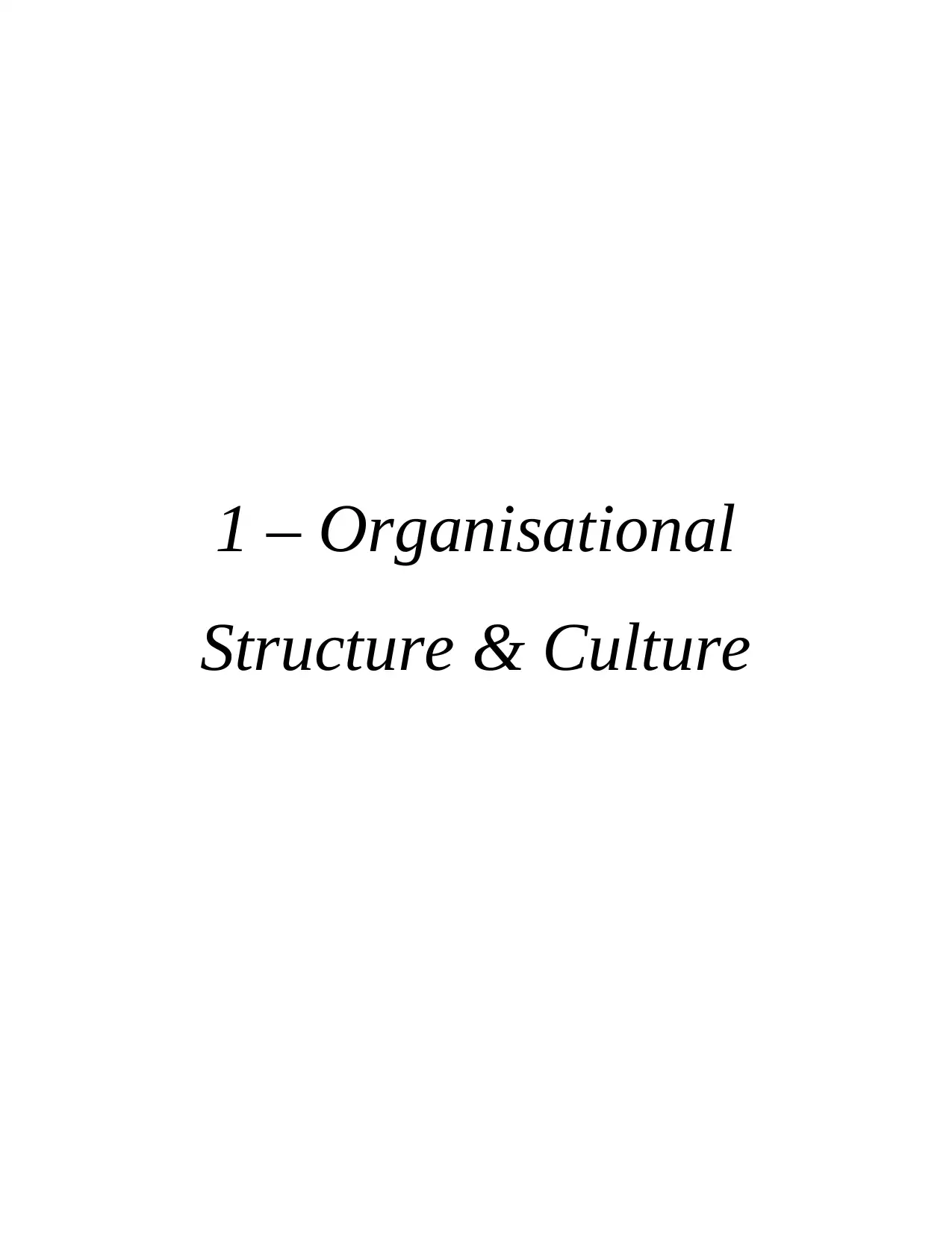
1 – Organisational
Structure & Culture
Structure & Culture
Paraphrase This Document
Need a fresh take? Get an instant paraphrase of this document with our AI Paraphraser
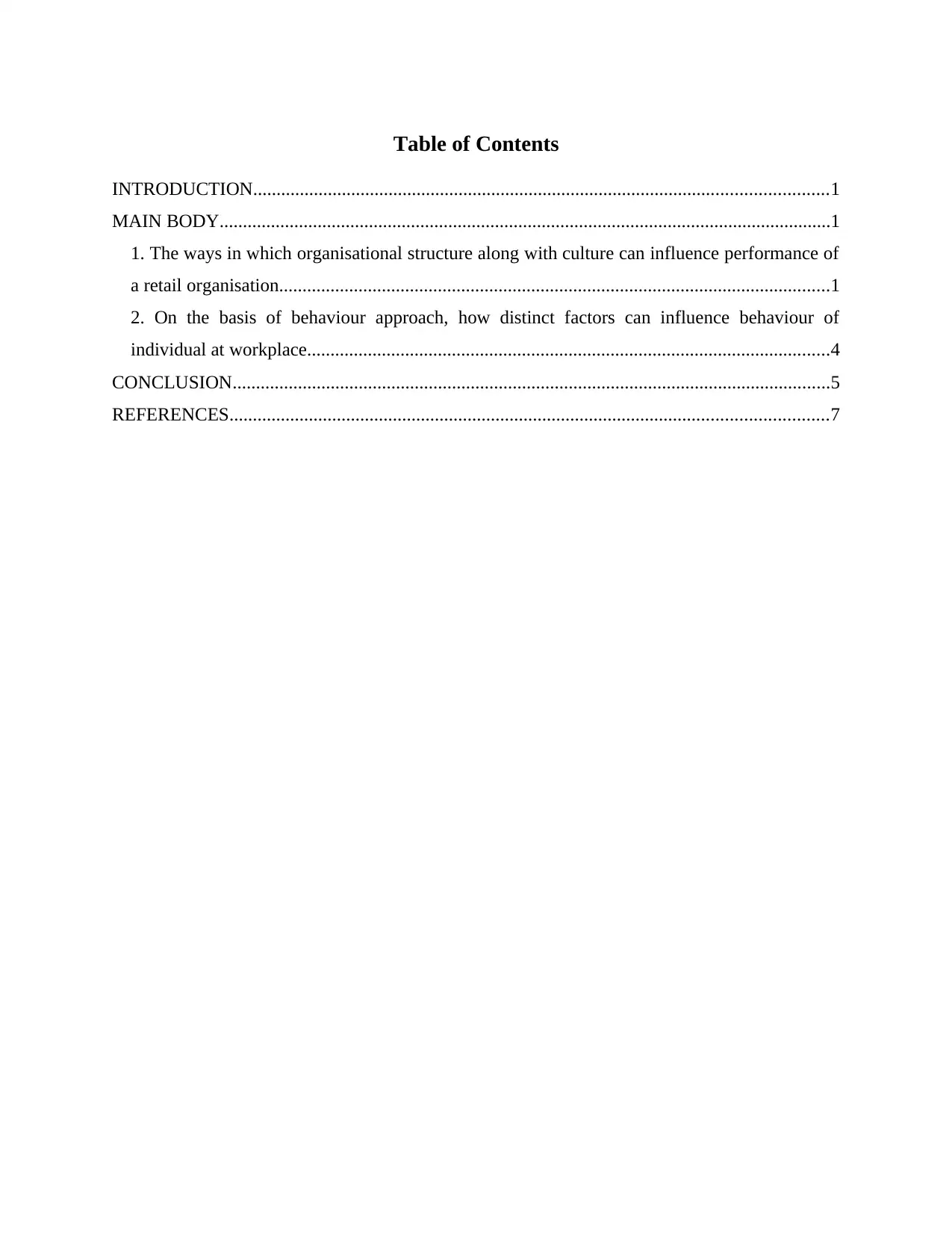
Table of Contents
INTRODUCTION...........................................................................................................................1
MAIN BODY...................................................................................................................................1
1. The ways in which organisational structure along with culture can influence performance of
a retail organisation......................................................................................................................1
2. On the basis of behaviour approach, how distinct factors can influence behaviour of
individual at workplace................................................................................................................4
CONCLUSION................................................................................................................................5
REFERENCES................................................................................................................................7
INTRODUCTION...........................................................................................................................1
MAIN BODY...................................................................................................................................1
1. The ways in which organisational structure along with culture can influence performance of
a retail organisation......................................................................................................................1
2. On the basis of behaviour approach, how distinct factors can influence behaviour of
individual at workplace................................................................................................................4
CONCLUSION................................................................................................................................5
REFERENCES................................................................................................................................7

⊘ This is a preview!⊘
Do you want full access?
Subscribe today to unlock all pages.

Trusted by 1+ million students worldwide
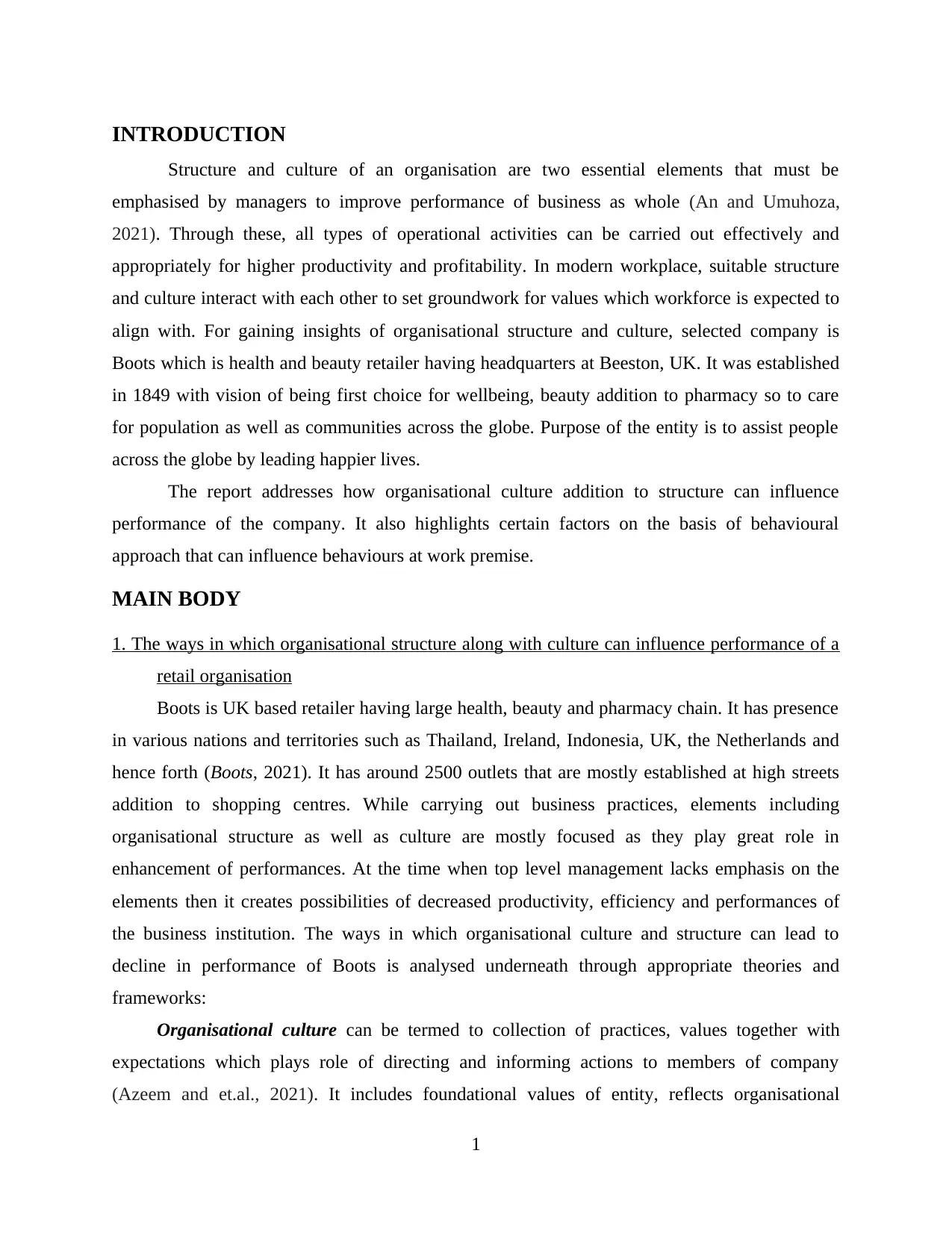
INTRODUCTION
Structure and culture of an organisation are two essential elements that must be
emphasised by managers to improve performance of business as whole (An and Umuhoza,
2021). Through these, all types of operational activities can be carried out effectively and
appropriately for higher productivity and profitability. In modern workplace, suitable structure
and culture interact with each other to set groundwork for values which workforce is expected to
align with. For gaining insights of organisational structure and culture, selected company is
Boots which is health and beauty retailer having headquarters at Beeston, UK. It was established
in 1849 with vision of being first choice for wellbeing, beauty addition to pharmacy so to care
for population as well as communities across the globe. Purpose of the entity is to assist people
across the globe by leading happier lives.
The report addresses how organisational culture addition to structure can influence
performance of the company. It also highlights certain factors on the basis of behavioural
approach that can influence behaviours at work premise.
MAIN BODY
1. The ways in which organisational structure along with culture can influence performance of a
retail organisation
Boots is UK based retailer having large health, beauty and pharmacy chain. It has presence
in various nations and territories such as Thailand, Ireland, Indonesia, UK, the Netherlands and
hence forth (Boots, 2021). It has around 2500 outlets that are mostly established at high streets
addition to shopping centres. While carrying out business practices, elements including
organisational structure as well as culture are mostly focused as they play great role in
enhancement of performances. At the time when top level management lacks emphasis on the
elements then it creates possibilities of decreased productivity, efficiency and performances of
the business institution. The ways in which organisational culture and structure can lead to
decline in performance of Boots is analysed underneath through appropriate theories and
frameworks:
Organisational culture can be termed to collection of practices, values together with
expectations which plays role of directing and informing actions to members of company
(Azeem and et.al., 2021). It includes foundational values of entity, reflects organisational
1
Structure and culture of an organisation are two essential elements that must be
emphasised by managers to improve performance of business as whole (An and Umuhoza,
2021). Through these, all types of operational activities can be carried out effectively and
appropriately for higher productivity and profitability. In modern workplace, suitable structure
and culture interact with each other to set groundwork for values which workforce is expected to
align with. For gaining insights of organisational structure and culture, selected company is
Boots which is health and beauty retailer having headquarters at Beeston, UK. It was established
in 1849 with vision of being first choice for wellbeing, beauty addition to pharmacy so to care
for population as well as communities across the globe. Purpose of the entity is to assist people
across the globe by leading happier lives.
The report addresses how organisational culture addition to structure can influence
performance of the company. It also highlights certain factors on the basis of behavioural
approach that can influence behaviours at work premise.
MAIN BODY
1. The ways in which organisational structure along with culture can influence performance of a
retail organisation
Boots is UK based retailer having large health, beauty and pharmacy chain. It has presence
in various nations and territories such as Thailand, Ireland, Indonesia, UK, the Netherlands and
hence forth (Boots, 2021). It has around 2500 outlets that are mostly established at high streets
addition to shopping centres. While carrying out business practices, elements including
organisational structure as well as culture are mostly focused as they play great role in
enhancement of performances. At the time when top level management lacks emphasis on the
elements then it creates possibilities of decreased productivity, efficiency and performances of
the business institution. The ways in which organisational culture and structure can lead to
decline in performance of Boots is analysed underneath through appropriate theories and
frameworks:
Organisational culture can be termed to collection of practices, values together with
expectations which plays role of directing and informing actions to members of company
(Azeem and et.al., 2021). It includes foundational values of entity, reflects organisational
1
Paraphrase This Document
Need a fresh take? Get an instant paraphrase of this document with our AI Paraphraser
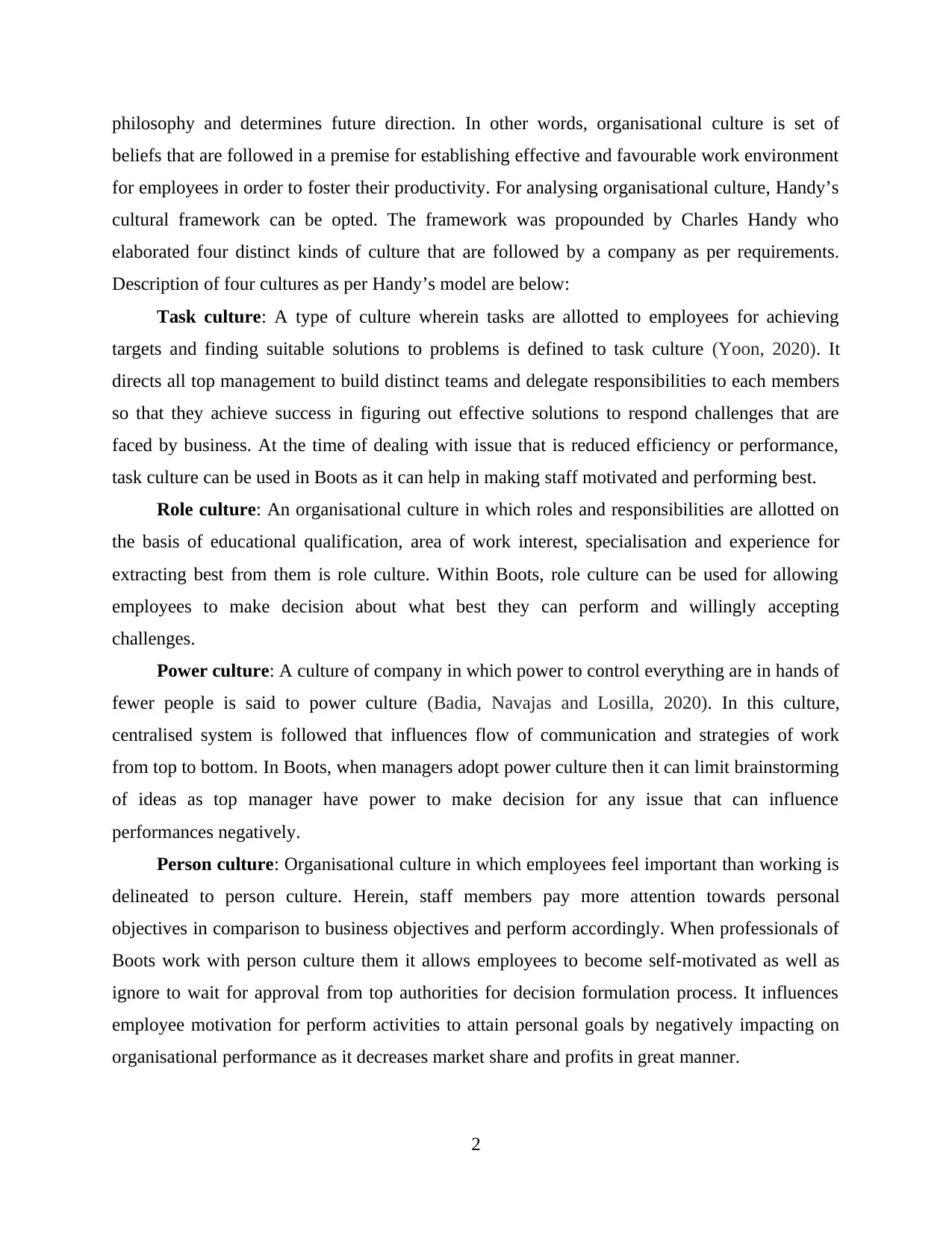
philosophy and determines future direction. In other words, organisational culture is set of
beliefs that are followed in a premise for establishing effective and favourable work environment
for employees in order to foster their productivity. For analysing organisational culture, Handy’s
cultural framework can be opted. The framework was propounded by Charles Handy who
elaborated four distinct kinds of culture that are followed by a company as per requirements.
Description of four cultures as per Handy’s model are below:
Task culture: A type of culture wherein tasks are allotted to employees for achieving
targets and finding suitable solutions to problems is defined to task culture (Yoon, 2020). It
directs all top management to build distinct teams and delegate responsibilities to each members
so that they achieve success in figuring out effective solutions to respond challenges that are
faced by business. At the time of dealing with issue that is reduced efficiency or performance,
task culture can be used in Boots as it can help in making staff motivated and performing best.
Role culture: An organisational culture in which roles and responsibilities are allotted on
the basis of educational qualification, area of work interest, specialisation and experience for
extracting best from them is role culture. Within Boots, role culture can be used for allowing
employees to make decision about what best they can perform and willingly accepting
challenges.
Power culture: A culture of company in which power to control everything are in hands of
fewer people is said to power culture (Badia, Navajas and Losilla, 2020). In this culture,
centralised system is followed that influences flow of communication and strategies of work
from top to bottom. In Boots, when managers adopt power culture then it can limit brainstorming
of ideas as top manager have power to make decision for any issue that can influence
performances negatively.
Person culture: Organisational culture in which employees feel important than working is
delineated to person culture. Herein, staff members pay more attention towards personal
objectives in comparison to business objectives and perform accordingly. When professionals of
Boots work with person culture them it allows employees to become self-motivated as well as
ignore to wait for approval from top authorities for decision formulation process. It influences
employee motivation for perform activities to attain personal goals by negatively impacting on
organisational performance as it decreases market share and profits in great manner.
2
beliefs that are followed in a premise for establishing effective and favourable work environment
for employees in order to foster their productivity. For analysing organisational culture, Handy’s
cultural framework can be opted. The framework was propounded by Charles Handy who
elaborated four distinct kinds of culture that are followed by a company as per requirements.
Description of four cultures as per Handy’s model are below:
Task culture: A type of culture wherein tasks are allotted to employees for achieving
targets and finding suitable solutions to problems is defined to task culture (Yoon, 2020). It
directs all top management to build distinct teams and delegate responsibilities to each members
so that they achieve success in figuring out effective solutions to respond challenges that are
faced by business. At the time of dealing with issue that is reduced efficiency or performance,
task culture can be used in Boots as it can help in making staff motivated and performing best.
Role culture: An organisational culture in which roles and responsibilities are allotted on
the basis of educational qualification, area of work interest, specialisation and experience for
extracting best from them is role culture. Within Boots, role culture can be used for allowing
employees to make decision about what best they can perform and willingly accepting
challenges.
Power culture: A culture of company in which power to control everything are in hands of
fewer people is said to power culture (Badia, Navajas and Losilla, 2020). In this culture,
centralised system is followed that influences flow of communication and strategies of work
from top to bottom. In Boots, when managers adopt power culture then it can limit brainstorming
of ideas as top manager have power to make decision for any issue that can influence
performances negatively.
Person culture: Organisational culture in which employees feel important than working is
delineated to person culture. Herein, staff members pay more attention towards personal
objectives in comparison to business objectives and perform accordingly. When professionals of
Boots work with person culture them it allows employees to become self-motivated as well as
ignore to wait for approval from top authorities for decision formulation process. It influences
employee motivation for perform activities to attain personal goals by negatively impacting on
organisational performance as it decreases market share and profits in great manner.
2
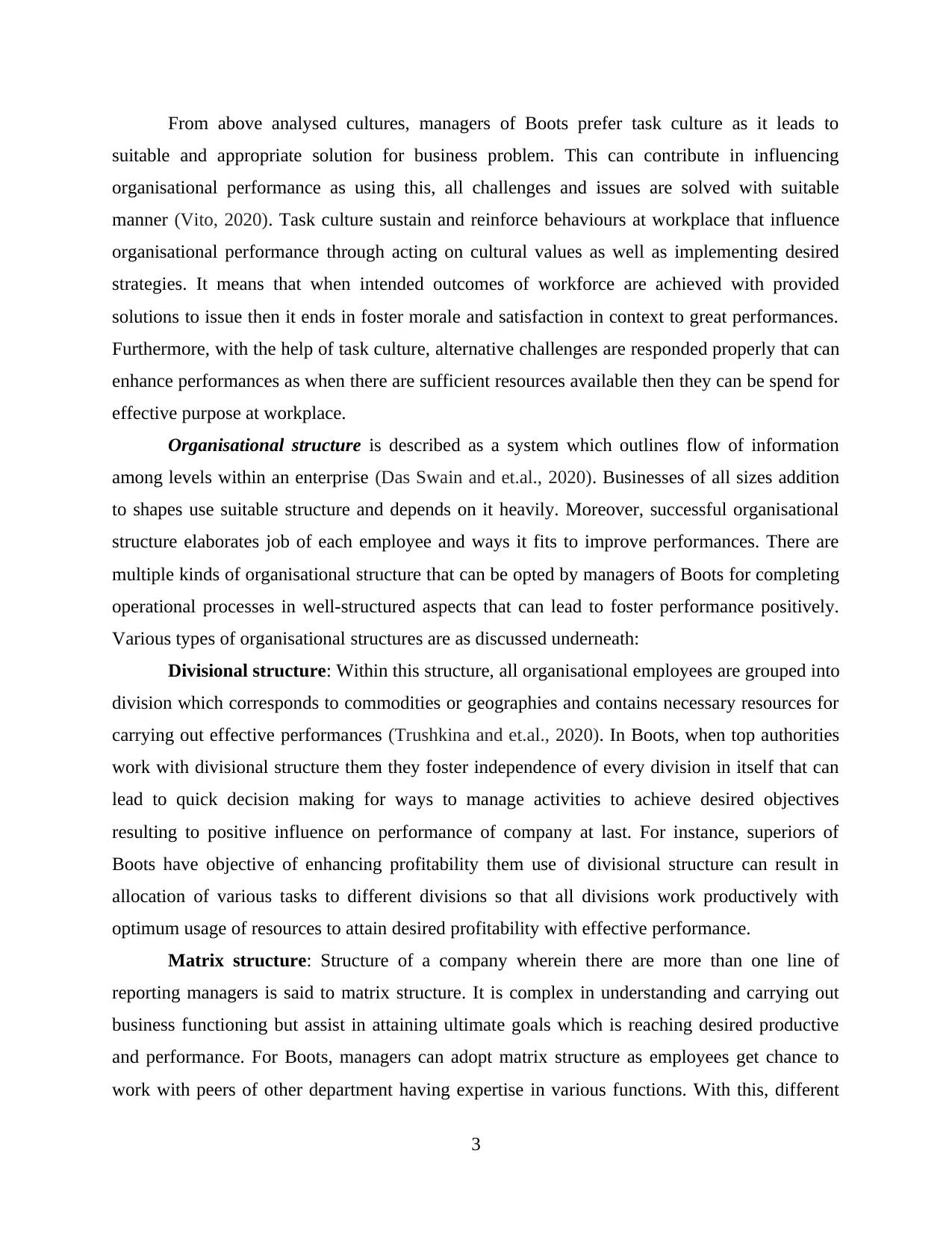
From above analysed cultures, managers of Boots prefer task culture as it leads to
suitable and appropriate solution for business problem. This can contribute in influencing
organisational performance as using this, all challenges and issues are solved with suitable
manner (Vito, 2020). Task culture sustain and reinforce behaviours at workplace that influence
organisational performance through acting on cultural values as well as implementing desired
strategies. It means that when intended outcomes of workforce are achieved with provided
solutions to issue then it ends in foster morale and satisfaction in context to great performances.
Furthermore, with the help of task culture, alternative challenges are responded properly that can
enhance performances as when there are sufficient resources available then they can be spend for
effective purpose at workplace.
Organisational structure is described as a system which outlines flow of information
among levels within an enterprise (Das Swain and et.al., 2020). Businesses of all sizes addition
to shapes use suitable structure and depends on it heavily. Moreover, successful organisational
structure elaborates job of each employee and ways it fits to improve performances. There are
multiple kinds of organisational structure that can be opted by managers of Boots for completing
operational processes in well-structured aspects that can lead to foster performance positively.
Various types of organisational structures are as discussed underneath:
Divisional structure: Within this structure, all organisational employees are grouped into
division which corresponds to commodities or geographies and contains necessary resources for
carrying out effective performances (Trushkina and et.al., 2020). In Boots, when top authorities
work with divisional structure them they foster independence of every division in itself that can
lead to quick decision making for ways to manage activities to achieve desired objectives
resulting to positive influence on performance of company at last. For instance, superiors of
Boots have objective of enhancing profitability them use of divisional structure can result in
allocation of various tasks to different divisions so that all divisions work productively with
optimum usage of resources to attain desired profitability with effective performance.
Matrix structure: Structure of a company wherein there are more than one line of
reporting managers is said to matrix structure. It is complex in understanding and carrying out
business functioning but assist in attaining ultimate goals which is reaching desired productive
and performance. For Boots, managers can adopt matrix structure as employees get chance to
work with peers of other department having expertise in various functions. With this, different
3
suitable and appropriate solution for business problem. This can contribute in influencing
organisational performance as using this, all challenges and issues are solved with suitable
manner (Vito, 2020). Task culture sustain and reinforce behaviours at workplace that influence
organisational performance through acting on cultural values as well as implementing desired
strategies. It means that when intended outcomes of workforce are achieved with provided
solutions to issue then it ends in foster morale and satisfaction in context to great performances.
Furthermore, with the help of task culture, alternative challenges are responded properly that can
enhance performances as when there are sufficient resources available then they can be spend for
effective purpose at workplace.
Organisational structure is described as a system which outlines flow of information
among levels within an enterprise (Das Swain and et.al., 2020). Businesses of all sizes addition
to shapes use suitable structure and depends on it heavily. Moreover, successful organisational
structure elaborates job of each employee and ways it fits to improve performances. There are
multiple kinds of organisational structure that can be opted by managers of Boots for completing
operational processes in well-structured aspects that can lead to foster performance positively.
Various types of organisational structures are as discussed underneath:
Divisional structure: Within this structure, all organisational employees are grouped into
division which corresponds to commodities or geographies and contains necessary resources for
carrying out effective performances (Trushkina and et.al., 2020). In Boots, when top authorities
work with divisional structure them they foster independence of every division in itself that can
lead to quick decision making for ways to manage activities to achieve desired objectives
resulting to positive influence on performance of company at last. For instance, superiors of
Boots have objective of enhancing profitability them use of divisional structure can result in
allocation of various tasks to different divisions so that all divisions work productively with
optimum usage of resources to attain desired profitability with effective performance.
Matrix structure: Structure of a company wherein there are more than one line of
reporting managers is said to matrix structure. It is complex in understanding and carrying out
business functioning but assist in attaining ultimate goals which is reaching desired productive
and performance. For Boots, managers can adopt matrix structure as employees get chance to
work with peers of other department having expertise in various functions. With this, different
3
⊘ This is a preview!⊘
Do you want full access?
Subscribe today to unlock all pages.

Trusted by 1+ million students worldwide
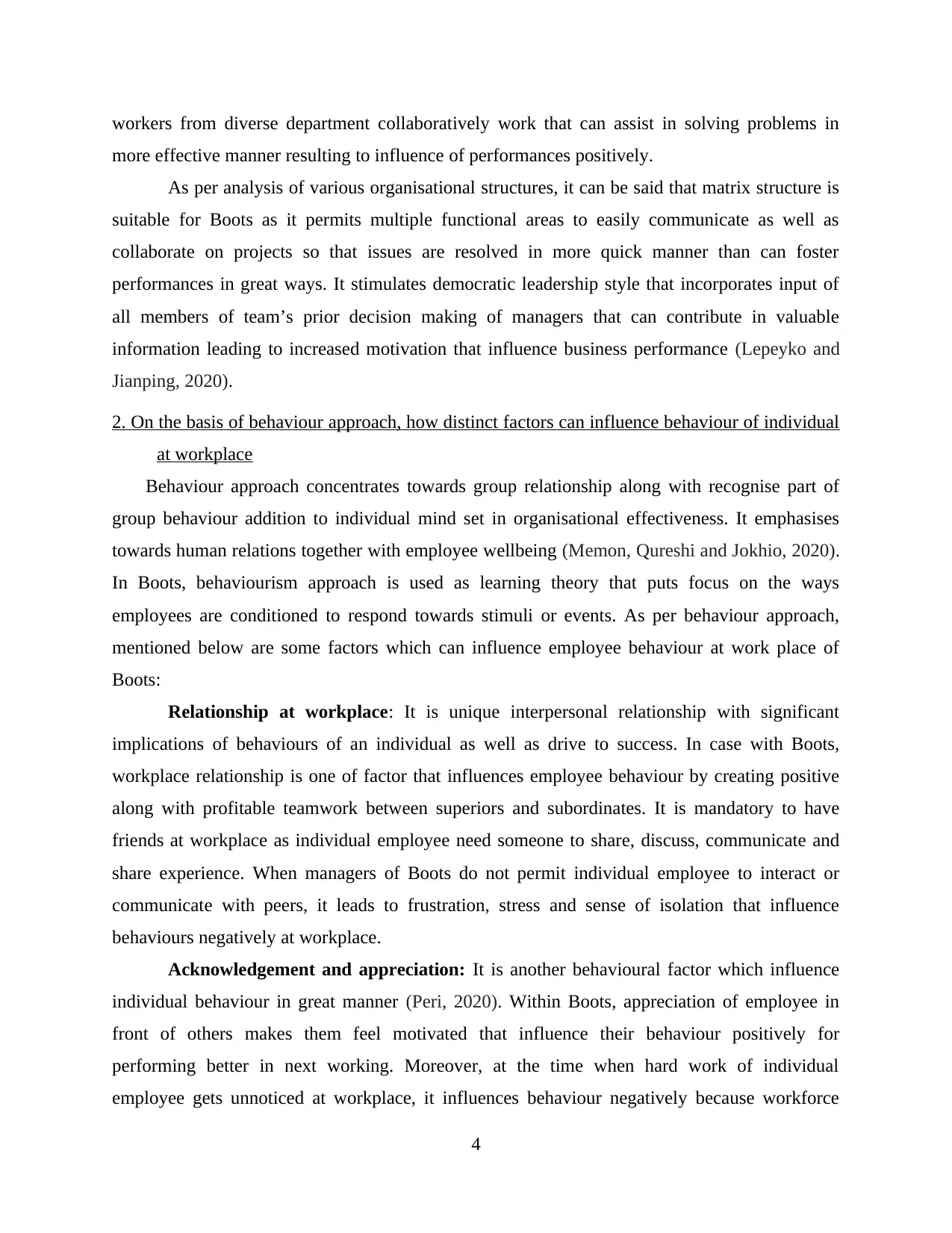
workers from diverse department collaboratively work that can assist in solving problems in
more effective manner resulting to influence of performances positively.
As per analysis of various organisational structures, it can be said that matrix structure is
suitable for Boots as it permits multiple functional areas to easily communicate as well as
collaborate on projects so that issues are resolved in more quick manner than can foster
performances in great ways. It stimulates democratic leadership style that incorporates input of
all members of team’s prior decision making of managers that can contribute in valuable
information leading to increased motivation that influence business performance (Lepeyko and
Jianping, 2020).
2. On the basis of behaviour approach, how distinct factors can influence behaviour of individual
at workplace
Behaviour approach concentrates towards group relationship along with recognise part of
group behaviour addition to individual mind set in organisational effectiveness. It emphasises
towards human relations together with employee wellbeing (Memon, Qureshi and Jokhio, 2020).
In Boots, behaviourism approach is used as learning theory that puts focus on the ways
employees are conditioned to respond towards stimuli or events. As per behaviour approach,
mentioned below are some factors which can influence employee behaviour at work place of
Boots:
Relationship at workplace: It is unique interpersonal relationship with significant
implications of behaviours of an individual as well as drive to success. In case with Boots,
workplace relationship is one of factor that influences employee behaviour by creating positive
along with profitable teamwork between superiors and subordinates. It is mandatory to have
friends at workplace as individual employee need someone to share, discuss, communicate and
share experience. When managers of Boots do not permit individual employee to interact or
communicate with peers, it leads to frustration, stress and sense of isolation that influence
behaviours negatively at workplace.
Acknowledgement and appreciation: It is another behavioural factor which influence
individual behaviour in great manner (Peri, 2020). Within Boots, appreciation of employee in
front of others makes them feel motivated that influence their behaviour positively for
performing better in next working. Moreover, at the time when hard work of individual
employee gets unnoticed at workplace, it influences behaviour negatively because workforce
4
more effective manner resulting to influence of performances positively.
As per analysis of various organisational structures, it can be said that matrix structure is
suitable for Boots as it permits multiple functional areas to easily communicate as well as
collaborate on projects so that issues are resolved in more quick manner than can foster
performances in great ways. It stimulates democratic leadership style that incorporates input of
all members of team’s prior decision making of managers that can contribute in valuable
information leading to increased motivation that influence business performance (Lepeyko and
Jianping, 2020).
2. On the basis of behaviour approach, how distinct factors can influence behaviour of individual
at workplace
Behaviour approach concentrates towards group relationship along with recognise part of
group behaviour addition to individual mind set in organisational effectiveness. It emphasises
towards human relations together with employee wellbeing (Memon, Qureshi and Jokhio, 2020).
In Boots, behaviourism approach is used as learning theory that puts focus on the ways
employees are conditioned to respond towards stimuli or events. As per behaviour approach,
mentioned below are some factors which can influence employee behaviour at work place of
Boots:
Relationship at workplace: It is unique interpersonal relationship with significant
implications of behaviours of an individual as well as drive to success. In case with Boots,
workplace relationship is one of factor that influences employee behaviour by creating positive
along with profitable teamwork between superiors and subordinates. It is mandatory to have
friends at workplace as individual employee need someone to share, discuss, communicate and
share experience. When managers of Boots do not permit individual employee to interact or
communicate with peers, it leads to frustration, stress and sense of isolation that influence
behaviours negatively at workplace.
Acknowledgement and appreciation: It is another behavioural factor which influence
individual behaviour in great manner (Peri, 2020). Within Boots, appreciation of employee in
front of others makes them feel motivated that influence their behaviour positively for
performing better in next working. Moreover, at the time when hard work of individual
employee gets unnoticed at workplace, it influences behaviour negatively because workforce
4
Paraphrase This Document
Need a fresh take? Get an instant paraphrase of this document with our AI Paraphraser
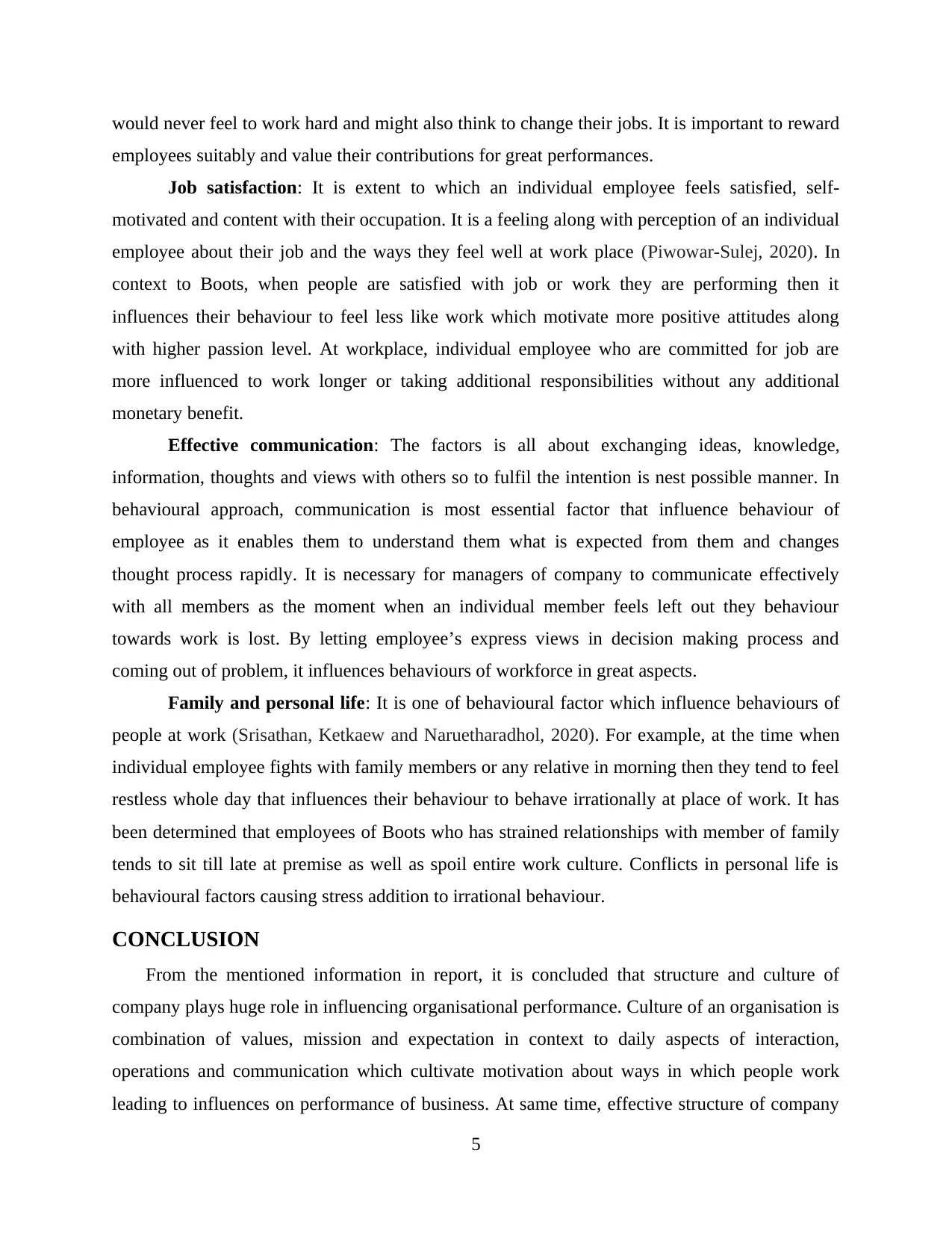
would never feel to work hard and might also think to change their jobs. It is important to reward
employees suitably and value their contributions for great performances.
Job satisfaction: It is extent to which an individual employee feels satisfied, self-
motivated and content with their occupation. It is a feeling along with perception of an individual
employee about their job and the ways they feel well at work place (Piwowar-Sulej, 2020). In
context to Boots, when people are satisfied with job or work they are performing then it
influences their behaviour to feel less like work which motivate more positive attitudes along
with higher passion level. At workplace, individual employee who are committed for job are
more influenced to work longer or taking additional responsibilities without any additional
monetary benefit.
Effective communication: The factors is all about exchanging ideas, knowledge,
information, thoughts and views with others so to fulfil the intention is nest possible manner. In
behavioural approach, communication is most essential factor that influence behaviour of
employee as it enables them to understand them what is expected from them and changes
thought process rapidly. It is necessary for managers of company to communicate effectively
with all members as the moment when an individual member feels left out they behaviour
towards work is lost. By letting employee’s express views in decision making process and
coming out of problem, it influences behaviours of workforce in great aspects.
Family and personal life: It is one of behavioural factor which influence behaviours of
people at work (Srisathan, Ketkaew and Naruetharadhol, 2020). For example, at the time when
individual employee fights with family members or any relative in morning then they tend to feel
restless whole day that influences their behaviour to behave irrationally at place of work. It has
been determined that employees of Boots who has strained relationships with member of family
tends to sit till late at premise as well as spoil entire work culture. Conflicts in personal life is
behavioural factors causing stress addition to irrational behaviour.
CONCLUSION
From the mentioned information in report, it is concluded that structure and culture of
company plays huge role in influencing organisational performance. Culture of an organisation is
combination of values, mission and expectation in context to daily aspects of interaction,
operations and communication which cultivate motivation about ways in which people work
leading to influences on performance of business. At same time, effective structure of company
5
employees suitably and value their contributions for great performances.
Job satisfaction: It is extent to which an individual employee feels satisfied, self-
motivated and content with their occupation. It is a feeling along with perception of an individual
employee about their job and the ways they feel well at work place (Piwowar-Sulej, 2020). In
context to Boots, when people are satisfied with job or work they are performing then it
influences their behaviour to feel less like work which motivate more positive attitudes along
with higher passion level. At workplace, individual employee who are committed for job are
more influenced to work longer or taking additional responsibilities without any additional
monetary benefit.
Effective communication: The factors is all about exchanging ideas, knowledge,
information, thoughts and views with others so to fulfil the intention is nest possible manner. In
behavioural approach, communication is most essential factor that influence behaviour of
employee as it enables them to understand them what is expected from them and changes
thought process rapidly. It is necessary for managers of company to communicate effectively
with all members as the moment when an individual member feels left out they behaviour
towards work is lost. By letting employee’s express views in decision making process and
coming out of problem, it influences behaviours of workforce in great aspects.
Family and personal life: It is one of behavioural factor which influence behaviours of
people at work (Srisathan, Ketkaew and Naruetharadhol, 2020). For example, at the time when
individual employee fights with family members or any relative in morning then they tend to feel
restless whole day that influences their behaviour to behave irrationally at place of work. It has
been determined that employees of Boots who has strained relationships with member of family
tends to sit till late at premise as well as spoil entire work culture. Conflicts in personal life is
behavioural factors causing stress addition to irrational behaviour.
CONCLUSION
From the mentioned information in report, it is concluded that structure and culture of
company plays huge role in influencing organisational performance. Culture of an organisation is
combination of values, mission and expectation in context to daily aspects of interaction,
operations and communication which cultivate motivation about ways in which people work
leading to influences on performance of business. At same time, effective structure of company
5
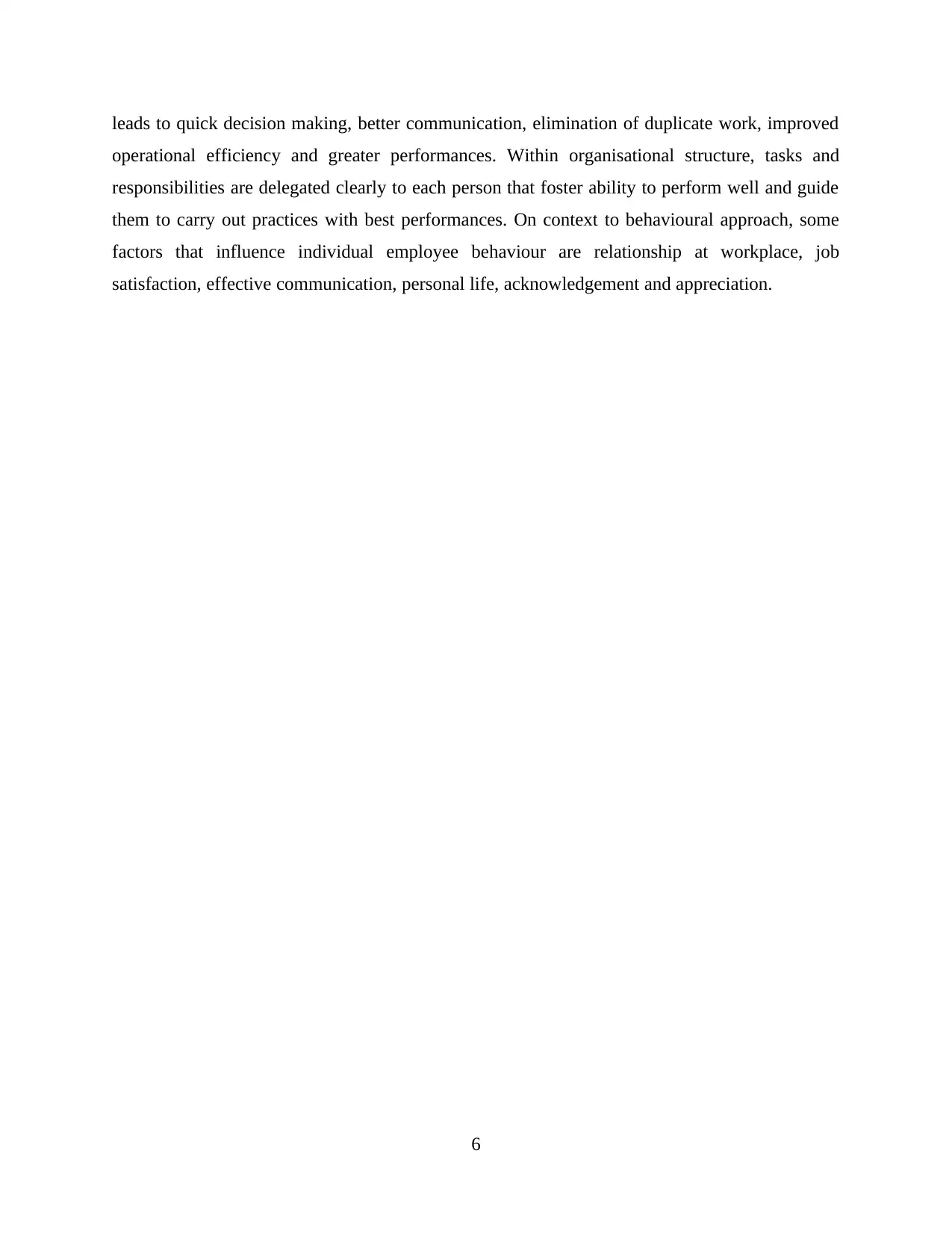
leads to quick decision making, better communication, elimination of duplicate work, improved
operational efficiency and greater performances. Within organisational structure, tasks and
responsibilities are delegated clearly to each person that foster ability to perform well and guide
them to carry out practices with best performances. On context to behavioural approach, some
factors that influence individual employee behaviour are relationship at workplace, job
satisfaction, effective communication, personal life, acknowledgement and appreciation.
6
operational efficiency and greater performances. Within organisational structure, tasks and
responsibilities are delegated clearly to each person that foster ability to perform well and guide
them to carry out practices with best performances. On context to behavioural approach, some
factors that influence individual employee behaviour are relationship at workplace, job
satisfaction, effective communication, personal life, acknowledgement and appreciation.
6
⊘ This is a preview!⊘
Do you want full access?
Subscribe today to unlock all pages.

Trusted by 1+ million students worldwide
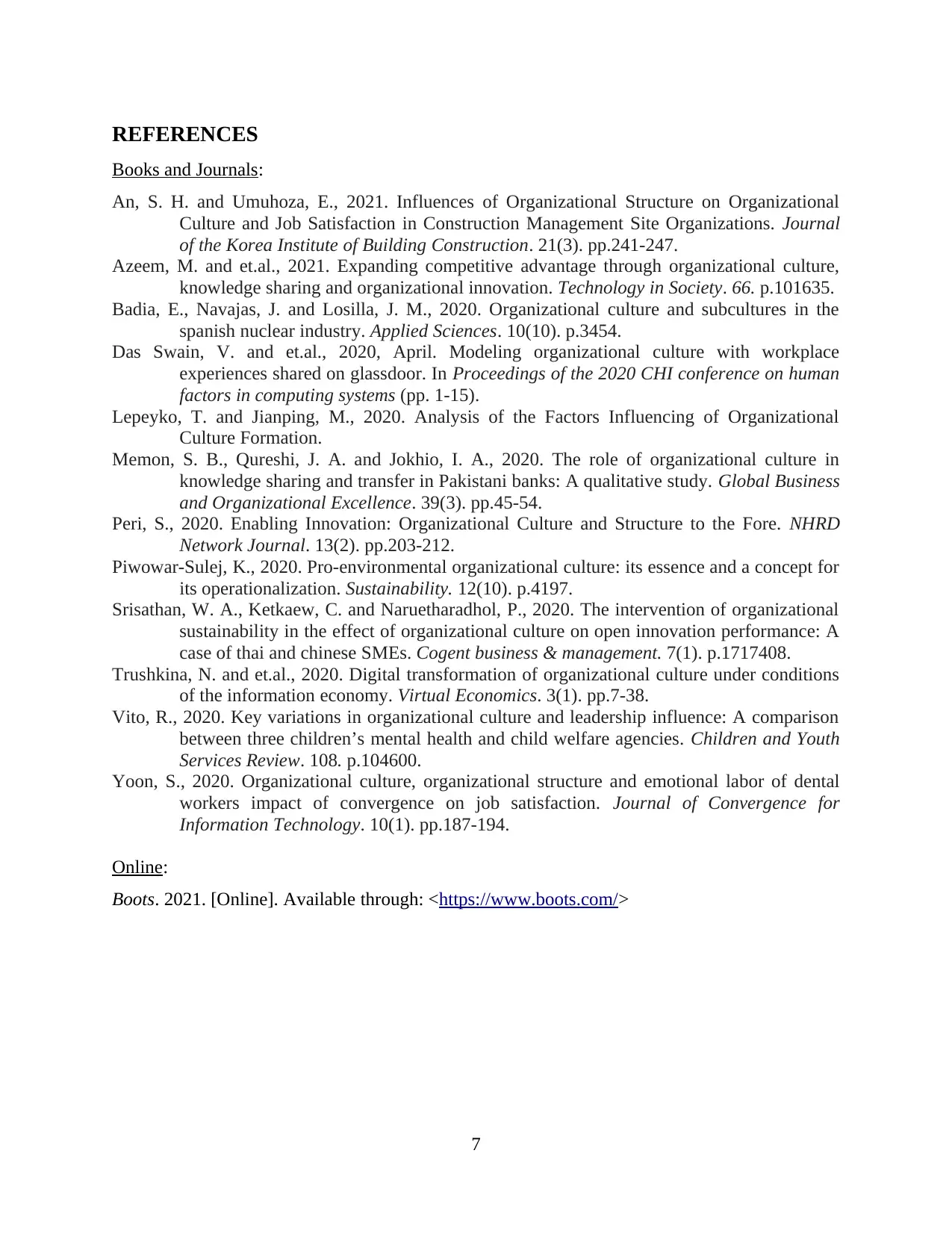
REFERENCES
Books and Journals:
An, S. H. and Umuhoza, E., 2021. Influences of Organizational Structure on Organizational
Culture and Job Satisfaction in Construction Management Site Organizations. Journal
of the Korea Institute of Building Construction. 21(3). pp.241-247.
Azeem, M. and et.al., 2021. Expanding competitive advantage through organizational culture,
knowledge sharing and organizational innovation. Technology in Society. 66. p.101635.
Badia, E., Navajas, J. and Losilla, J. M., 2020. Organizational culture and subcultures in the
spanish nuclear industry. Applied Sciences. 10(10). p.3454.
Das Swain, V. and et.al., 2020, April. Modeling organizational culture with workplace
experiences shared on glassdoor. In Proceedings of the 2020 CHI conference on human
factors in computing systems (pp. 1-15).
Lepeyko, T. and Jianping, M., 2020. Analysis of the Factors Influencing of Organizational
Culture Formation.
Memon, S. B., Qureshi, J. A. and Jokhio, I. A., 2020. The role of organizational culture in
knowledge sharing and transfer in Pakistani banks: A qualitative study. Global Business
and Organizational Excellence. 39(3). pp.45-54.
Peri, S., 2020. Enabling Innovation: Organizational Culture and Structure to the Fore. NHRD
Network Journal. 13(2). pp.203-212.
Piwowar-Sulej, K., 2020. Pro-environmental organizational culture: its essence and a concept for
its operationalization. Sustainability. 12(10). p.4197.
Srisathan, W. A., Ketkaew, C. and Naruetharadhol, P., 2020. The intervention of organizational
sustainability in the effect of organizational culture on open innovation performance: A
case of thai and chinese SMEs. Cogent business & management. 7(1). p.1717408.
Trushkina, N. and et.al., 2020. Digital transformation of organizational culture under conditions
of the information economy. Virtual Economics. 3(1). pp.7-38.
Vito, R., 2020. Key variations in organizational culture and leadership influence: A comparison
between three children’s mental health and child welfare agencies. Children and Youth
Services Review. 108. p.104600.
Yoon, S., 2020. Organizational culture, organizational structure and emotional labor of dental
workers impact of convergence on job satisfaction. Journal of Convergence for
Information Technology. 10(1). pp.187-194.
Online:
Boots. 2021. [Online]. Available through: <https://www.boots.com/>
7
Books and Journals:
An, S. H. and Umuhoza, E., 2021. Influences of Organizational Structure on Organizational
Culture and Job Satisfaction in Construction Management Site Organizations. Journal
of the Korea Institute of Building Construction. 21(3). pp.241-247.
Azeem, M. and et.al., 2021. Expanding competitive advantage through organizational culture,
knowledge sharing and organizational innovation. Technology in Society. 66. p.101635.
Badia, E., Navajas, J. and Losilla, J. M., 2020. Organizational culture and subcultures in the
spanish nuclear industry. Applied Sciences. 10(10). p.3454.
Das Swain, V. and et.al., 2020, April. Modeling organizational culture with workplace
experiences shared on glassdoor. In Proceedings of the 2020 CHI conference on human
factors in computing systems (pp. 1-15).
Lepeyko, T. and Jianping, M., 2020. Analysis of the Factors Influencing of Organizational
Culture Formation.
Memon, S. B., Qureshi, J. A. and Jokhio, I. A., 2020. The role of organizational culture in
knowledge sharing and transfer in Pakistani banks: A qualitative study. Global Business
and Organizational Excellence. 39(3). pp.45-54.
Peri, S., 2020. Enabling Innovation: Organizational Culture and Structure to the Fore. NHRD
Network Journal. 13(2). pp.203-212.
Piwowar-Sulej, K., 2020. Pro-environmental organizational culture: its essence and a concept for
its operationalization. Sustainability. 12(10). p.4197.
Srisathan, W. A., Ketkaew, C. and Naruetharadhol, P., 2020. The intervention of organizational
sustainability in the effect of organizational culture on open innovation performance: A
case of thai and chinese SMEs. Cogent business & management. 7(1). p.1717408.
Trushkina, N. and et.al., 2020. Digital transformation of organizational culture under conditions
of the information economy. Virtual Economics. 3(1). pp.7-38.
Vito, R., 2020. Key variations in organizational culture and leadership influence: A comparison
between three children’s mental health and child welfare agencies. Children and Youth
Services Review. 108. p.104600.
Yoon, S., 2020. Organizational culture, organizational structure and emotional labor of dental
workers impact of convergence on job satisfaction. Journal of Convergence for
Information Technology. 10(1). pp.187-194.
Online:
Boots. 2021. [Online]. Available through: <https://www.boots.com/>
7
1 out of 10
Related Documents
Your All-in-One AI-Powered Toolkit for Academic Success.
+13062052269
info@desklib.com
Available 24*7 on WhatsApp / Email
![[object Object]](/_next/static/media/star-bottom.7253800d.svg)
Unlock your academic potential
Copyright © 2020–2025 A2Z Services. All Rights Reserved. Developed and managed by ZUCOL.




